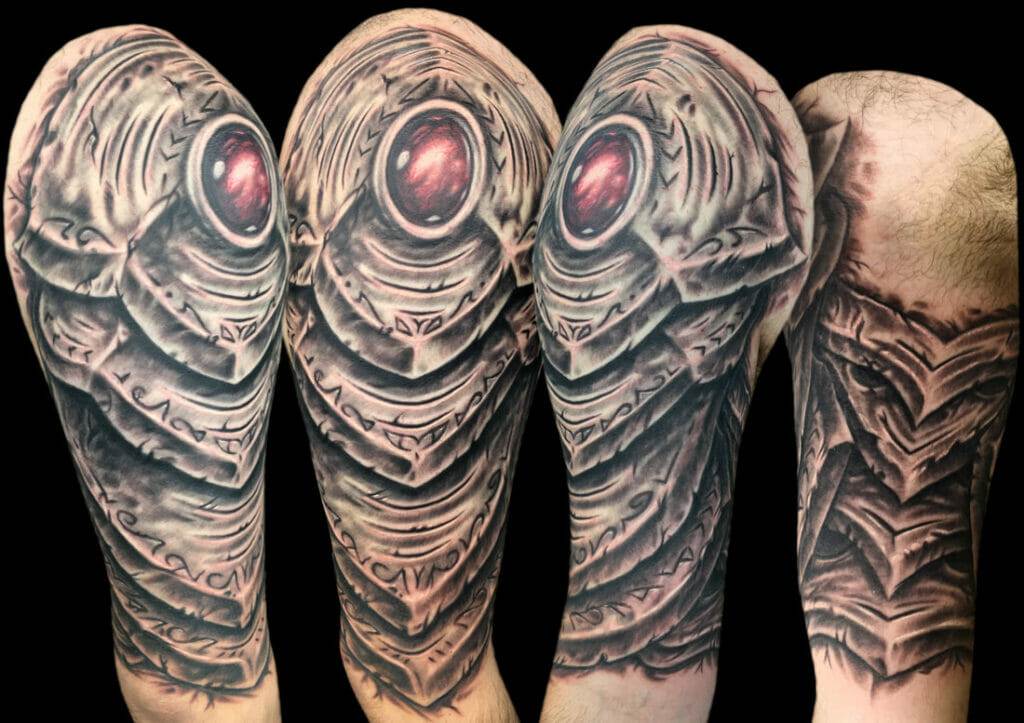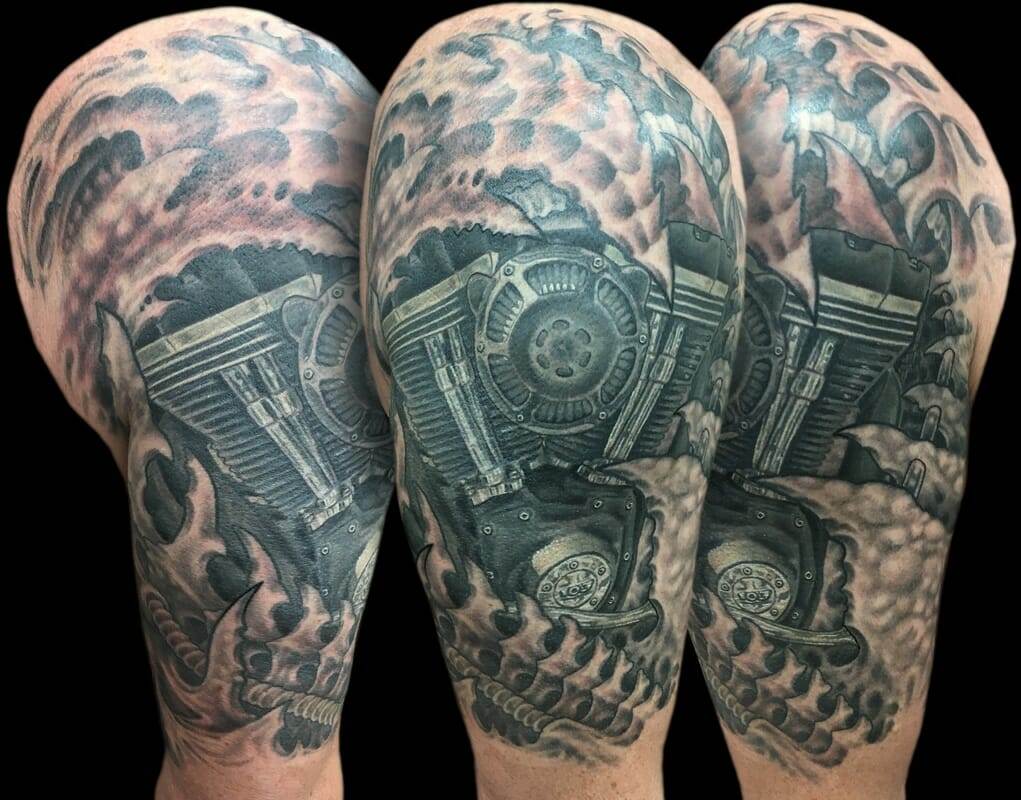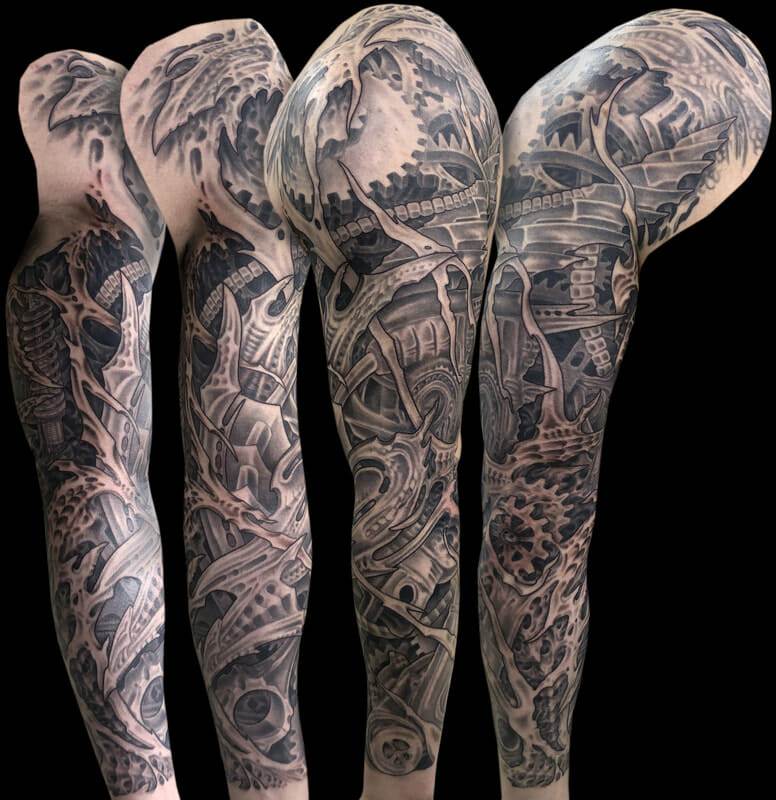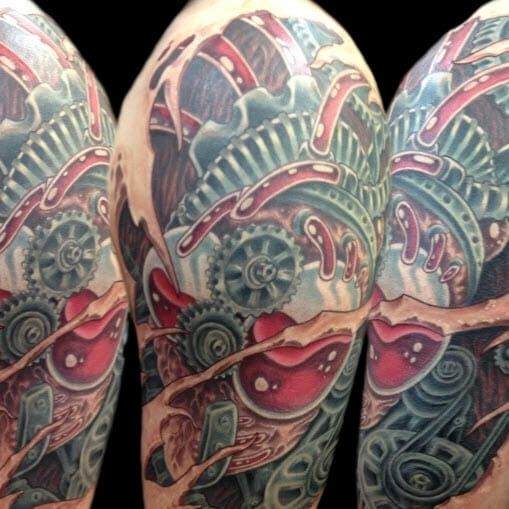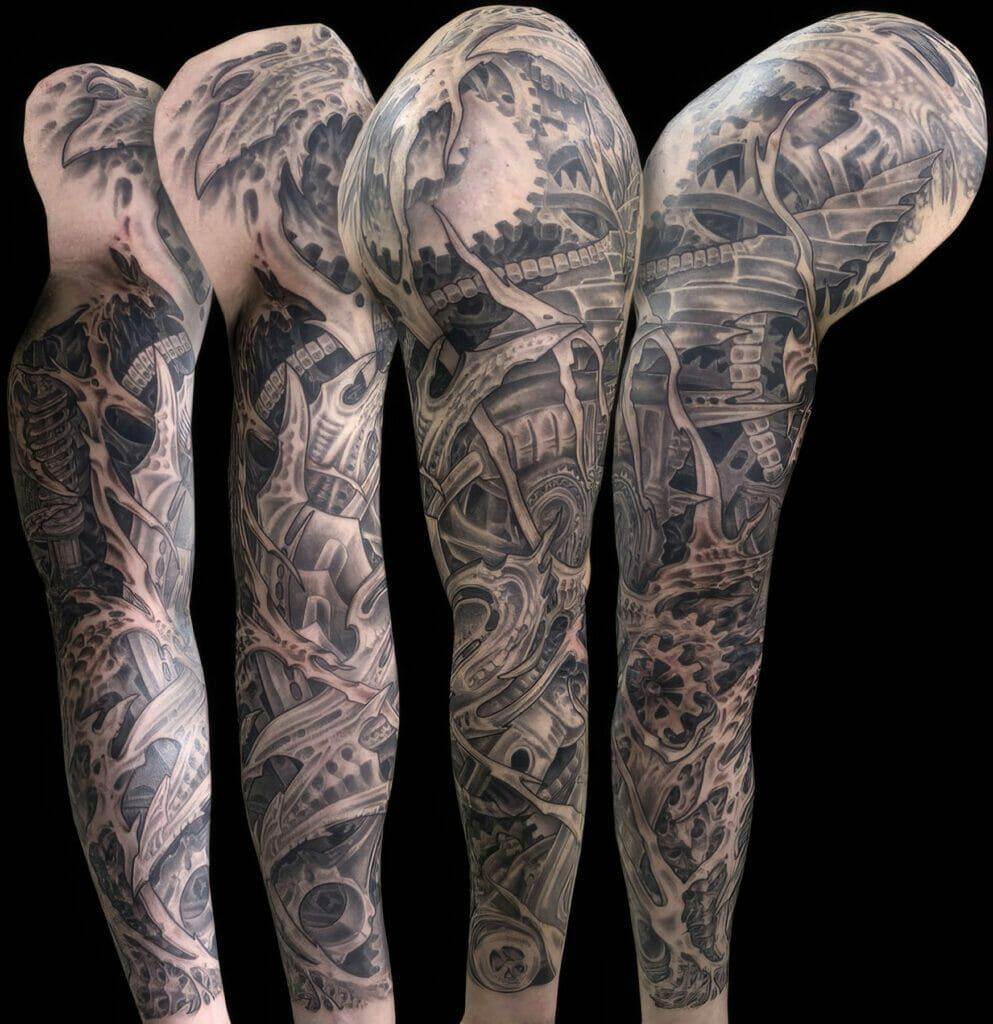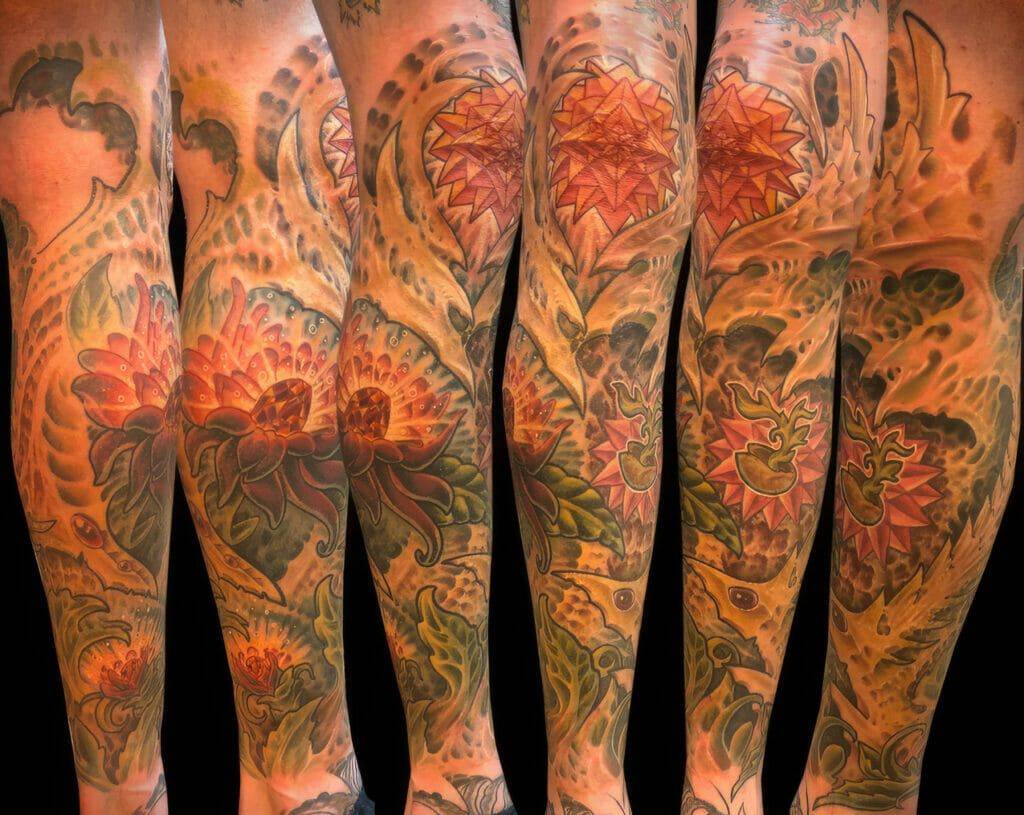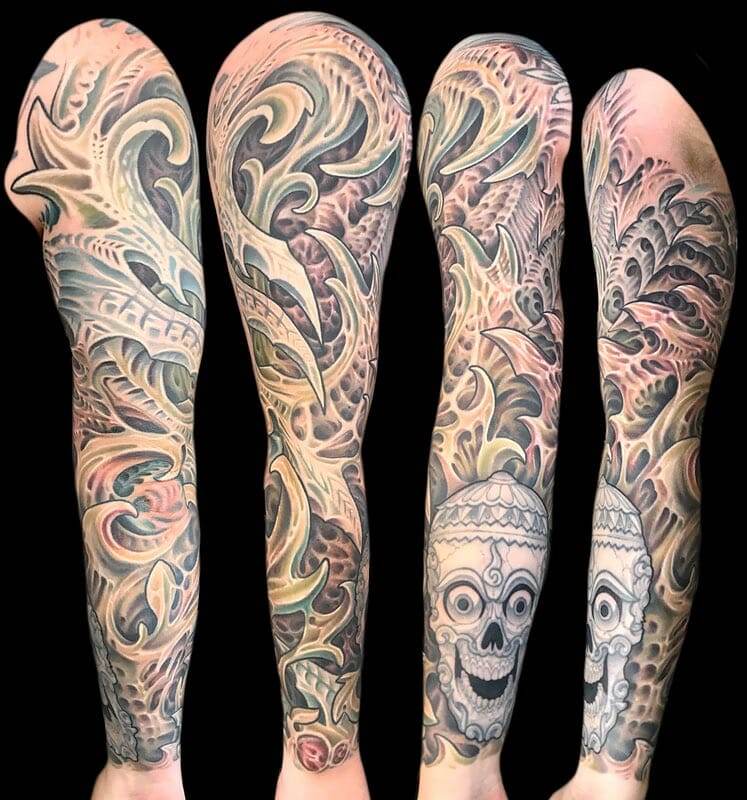Biomechanical tattoos are a unique type of tattoo that combines mechanical and organic elements to create a futuristic, cyborg-like look. These tattoos are an excellent option for people who love science fiction and technology and want a tattoo that looks like it belongs to a futuristic world. In this blog, we’ll explore the definition of biomechanical tattoos, their history, and popular themes and designs.
Definition of biomechanical tattoos:
Biomechanical tattoos are a type of tattoo that mimics mechanical parts overlaid onto human tissues and bones, creating the illusion that the tattoo is a part of the wearer’s biology. These tattoos often feature mechanical elements (such as gears, wires, and robotic parts) that are woven into the design of the tattoo. Biomechanical tattoos can be done in either black and white or with vivid colors and are usually placed on areas of the body that allow for the full expression of the design’s complexity.
History of biomechanical tattoos:
Biomechanical tattoos first appeared in the early 1980s, where they were popularized by Swiss artist H.R Giger, who designed the Alien film franchise’s eponymous creature. The biomechanical style later became famous through the work of tattoo artists like Guy Aitchison, who helped to refine and popularize the style. The biomechanical style quickly gained popularity and became a staple of science fiction and fantasy genres.
Popular themes and designs:
Biomechanical tattoos often feature robotic or cybernetic parts of the human body. Some popular designs include arms or legs that appear to be replaced with robotic limbs, hands or feet with metallic bones, and gears integrated with tissue. The designs are usually complex and are intended to give an impression of depth and dimensionality. Biomechanical tattoos can be customized to fit the individual’s taste, so designs can be created that show organic material seamlessly melding with mechanical parts, among others.
Anatomy of Biomechanical Tattoos
Biomechanical tattoos combine elements of machinery and biology to create visually striking designs. These tattoos often feature intricate details and a futuristic or cyborg-like appearance. Here are some key elements of biomechanical tattoos:
Elements of biomechanical tattoos
Biomechanical tattoos often include mechanical elements such as gears, wires, and robotic parts. These elements are intricately woven into the design of the tattoo, mimicking the appearance of mechanical parts fused with human skin and bones. The tattoos may also incorporate elements of science fiction and fantasy.
Organic and mechanical components
Biomechanical tattoos blend organic and mechanical components to create a unique and striking aesthetic. In some designs, the mechanical components may appear to be integrated seamlessly into the wearer’s body, while in others they may appear to be replacing organic parts entirely. This merging of organic and mechanical elements is a hallmark of the biomechanical tattoo style.
Incorporation of realistic elements
Biomechanical tattoos often incorporate realistic elements to create a lifelike and dimensional appearance. Some designs may include metallic bones, realistic-looking wires and cables, or synthetic tissue that appears to integrate seamlessly with the wearer’s own skin. The incorporation of realistic elements is essential to creating a biomechanical tattoo design that looks like a natural extension of the wearer’s body.
Biomechanical Tattoos: Pain and Healing Process
Pain and discomfort associated with biomechanical tattoos
Getting a tattoo can be a painful experience, and biomechanical tattoos are no exception. The intricate details and use of shading techniques can make the process even more uncomfortable. The level of pain can vary depending on the size and location of the tattoo. Areas with less flesh and more bone, such as the ankle or spine, may be more painful than larger muscle areas such as the upper arm or thigh.
To ease the discomfort, tattoo artists may use numbing creams or offer breaks during the tattooing process. It’s important to communicate with the artist if the pain becomes too much to bear.
After the tattoo is completed, the healing process can take anywhere from a few days to a few weeks. The area may be sore, red, and swollen for the first few days, and scabbing and peeling may occur as the tattoo heals.
It’s important to follow the artist’s aftercare instructions, such as avoiding soaking the tattoo in water and applying ointment to keep the area moisturized. With proper care, a biomechanical tattoo can heal properly and maintain its striking appearance for years to come.
Biomechanical Tattoos on Different Body Parts
Popular Body Parts for Biomechanical Tattoos
Biomechanical tattoos can be applied to various parts of the body, but some areas are more popular than others. The chest, upper and lower arms, back, and thighs are some of the most common locations to get this type of tattoo. Many people opt for larger designs that encompass the entire area, while others prefer smaller, more discreet tattoos.
Tattoo Design Adjustments for Different Body Parts
When designing a biomechanical tattoo, it’s essential to consider the body part it will be applied to. The curves and contours of the body can significantly impact the appearance of the tattoo. For instance, applying a straight-line design to the curved area of the back can create an inconsistent look.
Additionally, some areas, such as the hands and feet, may experience more wear and tear than others, making it crucial to select a design that can endure. To achieve the best outcome, it’s important to discuss these concerns with the tattoo artist beforehand.
In summary, biomechanical tattoos can be applied to various parts of the body, but some areas are more popular than others, and each body part requires specific design adjustments to enhance the tattoo’s appearance and longevity.
Biomechanical Tattoos and Sci-Fi Culture
Influence of science fiction on biomechanical tattoos
Science fiction has long influenced the tattoo industry, particularly in the realm of biomechanical tattoos. The genre’s depictions of futuristic technology and advanced cybernetics have inspired tattoo artists to create intricate designs that incorporate mechanical, robotic, and futuristic elements. These tattoos aim to represent the merging of man and machine, embodying the idea of technologically enhanced human beings.
Popular sci-fi motifs and themes
Some of the iconic sci-fi motifs and themes that commonly appear in biomechanical tattoos include cyborgs, robots, spaceships, and alien technology. These designs often feature intricate mechanical components and abstract shapes that come together to create a futuristic and otherworldly appearance. The combination of man and machine is a recurring theme in this genre, where technology is perceived as a way to enhance human capabilities and transcend our limitations.
In conclusion, biomechanical tattoos are deeply intertwined with sci-fi culture. This art form allows individuals to express their fascination with futuristic and technological advancements in a visually striking way. Whether one opts for a small or large biomechanical tattoo, they are sure to showcase an amalgamation of man and machine that is unique and captivating.
Biomechanical Tattoos and Symbolism
Symbolic representation of biomechanical tattoos
Biomechanical tattoos represent a fusion of machinery and human flesh, creating a unique and distinctive design. These tattoos can symbolize transformation or the evolution of human beings into technologically enhanced versions of themselves. They can also represent the boundary between the natural and artificial worlds and the blurred lines between reality and science fiction. Additionally, the intricate designs of biomechanical tattoos can express the idea of complexity and the interconnectedness of various parts of life.
Interpretation of biomechanical tattoo designs
The interpretation of biomechanical tattoo designs can vary from person to person. For some, these tattoos can symbolize the process of healing or transformation, while for others, they may represent the acceptance of technology into our lives. Some individuals may opt for these tattoos because of their love for sci-fi and futuristic technology, while others may see them as a way to convey their admiration for the intricate mechanics of the human body.
In conclusion, biomechanical tattoos are popular for their unique and striking designs and symbolic representation of the relationship between man and machine. The interpretation of these tattoos can be personal and varied but often represent themes of transformation, technology, and complexity.

